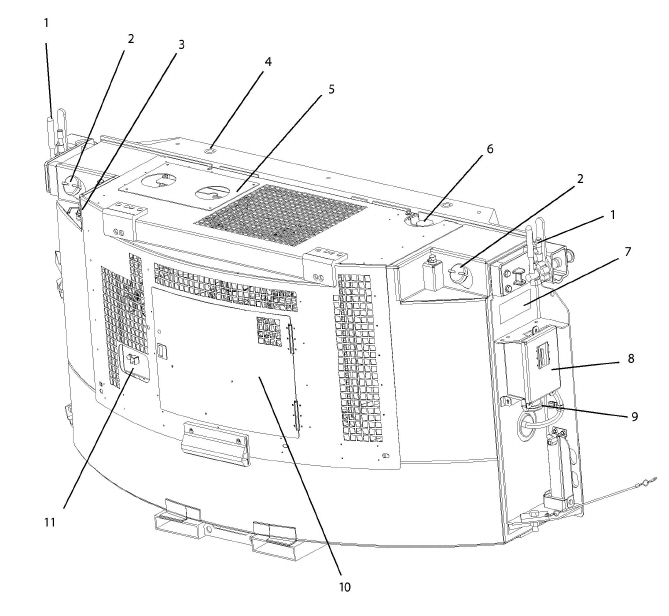
Section 2
The Carrier Transicold model 69RG15 clip-on diesel driven generator sets provide electrical power for all-electric refrigeration units.
The generator set (see Figure 2.1 and Figure 2.2) consists of a diesel engine direct-connected to an alternating current generator and mounted in a structural steel frame. The engine is a vertical in-line, four cylinder diesel manufactured by Kubota, while the generator is a 15 kW, brushless, single bearing type manufactured by Lima. The generator provides a constant 460 VAC, three-phase, 60 hertz electrical supply.
Electrical controls are mounted in a control box with operating controls and gauges mounted on a control panel (which also serves as the control box cover). The control panel components are protected by a deflector assembly or a windowed control box door.
Auxiliary engine equipment consists of the battery, solid state battery charging system, “spin-on” lube oil filter, fuel filter and other necessary components for proper unit operation. The water pump and the radiator cooling fan are belt-driven from the engine crankshaft. All references to engine are as viewed from the fly wheel end.
The 69RG15 is available as a standard configuration, with an Auto Restart option. The Auto Restart option automatically restarts the unit in the event of a unit shutdown.
Carrier Transicold’s Ecodriven dual speed option provides an energy saving alternative to the practice of continuously running the generator at full speed. This speed reduction results in increased fuel economy, reduced carbon footprint, and lowers operating costs.
2.2CONFIGURATION IDENTIFICATION
Generator set identification information is provided on a plate located below the right mounting clamp (front facing). The plate provides the generator set model number, serial number, and parts identification number (PID). The model number identifies the overall configuration while the PID provides information on specific optional equipment and differences in detailed parts.
Configuration identification for models covered herein are provided in Table 2–1. The model number, serial number and PID number must be included when ordering parts and inquiring about your unit.
Separately bound manuals covering the diesel engine are also available (see the following chart).
Manual/ Form No. |
Equipment Covered |
Type of Manual |
|---|---|---|
62-11335 |
V2203-DI |
Engine Part List |
62-11362 |
V2203-DI |
Workshop |
Model (69RG15-) |
PID |
Schematic and Diagram Figures |
Specs |
|---|---|---|---|
1400 Series, Single Speed |
|||
130C−05 |
RG1450 |
A2, B1, C1 |
|
RG1411 |
A2, B1, C1 |
||
130C−07 |
RG1403 |
A2, B2, C3 |
|
RG1409 |
A2, B2, C3 |
||
130P−06 |
RG1406 |
A1, B1, C1 |
|
RG1407 |
A1, B1, C1 |
||
RG1412 |
A1, B1, C1 |
||
RG1413 |
A1, B1, C1 |
||
130P−07 |
RG1402 |
A1, B1, C2 |
|
RG1408 |
A1, B1, C2 |
||
130W−05 |
RG1404 |
A3, B1, C1 |
|
RG1410 |
A3, B1, C1 |
||
1500 Series, Dual Speed |
|||
130C−08 |
RG1514 |
A2, B1, C4 |
|
RG1515 |
A2, B1, C4 |
||
RG1520 |
A2, B3, C4 |
||
130P−07 |
RG1502 |
A1, B1, C7 |
|
130W−05 |
RG1504 |
A1, B1, C7 |
|
130W−08 |
RG1518 |
A1, B3, C4 |
|
130P−08 |
RG1519 |
A1, B3, C4 |
|
130C−05 |
RG1521 |
A2, B1, C7 |
|
1600 Series, Dual Speed Provision |
|||
130W−05 |
RG1604 |
A1, B1, C8 |
|
RG1616 |
A1, B1, C8 |
||
RG1624 |
A1, B1, C8 |
||
130C−05 |
RG1621 |
A2, B1, C8 |
|
RG1623 |
A2, B1, C8 |
||
130P−06 |
RG1613 |
A1, B1, C8 |
|
LEGEND
•A1-Pin Mount
•A2-Clamp Mount
•A3-Pin Mount with Clamp Provision
•B1-Receptacle, Standard
•B2-Receptacle, Time Delay
•B3-Receptacle, GPS
•C1-Control Box, Standard
•C2-Control Box, Auto Restart
•C3-Control Box, Auto Restart and Time Delay
•C4-Control Box, Dual Speed, GPS
•C5-Control Box, Auto Restart, Dual Speed
•C6-Control Box, Auto Restart, Dual Speed, Time Delay
•C7-Control Box, Dual Speed
•C8-Control Box, Standard, 2 Speed Provision

1.Mounting Clamp (Optional)
2.Fuel Cap
3.Fuel Gauge (Either Side)
4.Mounting Pin
5.Battery Access Panel
6.Radiator Cap
7.Unit Model, Serial & PID Plate
8.Circuit Breaker (CB1)
9.Receptacle
10.Access Door
11.Control Box
- - - - -
Figure 2.2 Generator Set - Top Cover Removed
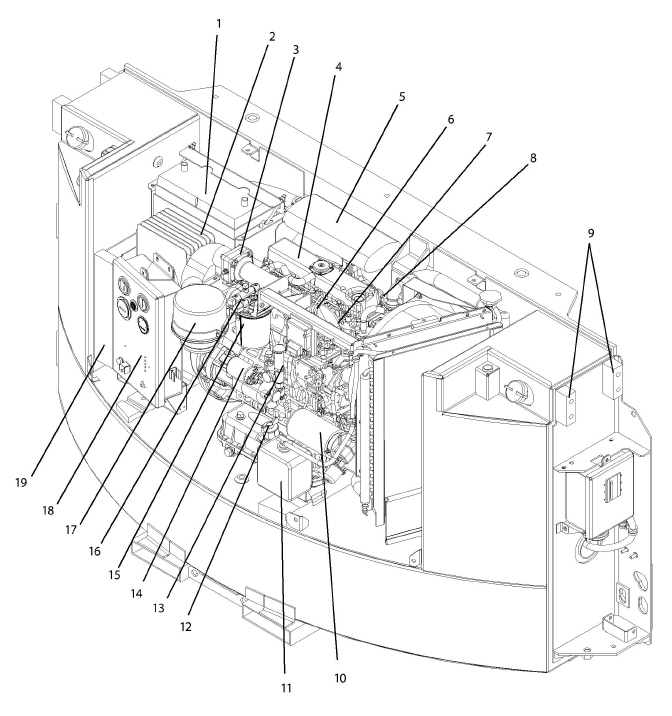
1.Battery
2.Solid State Battery Charger
3.Intake Heater (IH)
4.Engine
5.Exhaust Muffler
6.Injection Pump
7.Fuel Warmer (If Equipped)
8.Water Temperature Sender
9.Mounting Blocks
10.Engine Oil Filter
11.Coolant Recovery Bottle
12.Lube Oil Dip Stick/Fill Cap
13.Mechanical Fuel Pump
14.Starter Motor
15.Fuel Filter
16.Fuel Heater (If Equipped)
17.Air Cleaner
18.Control
Box and Panel
(see Figure
2.7 or Figure
2.8)
19.Alternating Current Generator
- - - - -
The engine is a vertical, in-line four cylinder diesel engine, which is direct-connected to the alternating current generator. Information on the major engine systems is provided in the following sub-paragraphs.
2.3.1Electronic Governor Module
The electronic governor module (EG) is a solid state control module preprogrammed for 1800 RPM high speed and 1500 RPM low speed operation. The electronic governor module, along with the engine speed sensor, replaced the manual governor in order to provide constant and economical engine speed.
The unit has an LED which may be used to diagnose failures within the electronic speed control system, refer to Section 4.6 for additional troubleshooting information on diagnosing failures.
Figure 2.3 Electronic Governor Module
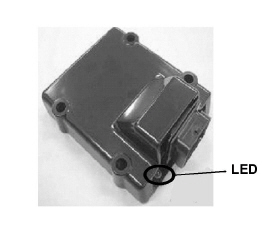
The air cleaner (Figure 2.2) is designed to prolong engine life and performance by preventing dirt and grit from entering the engine and causing excessive wear on all operating parts. In order for the air filter to operate properly, the operator must regularly maintain the air cleaner equipment in accordance with the instructions provided within this document.
The fuel system is fitted with an in-line fuel strainer and a fuel filter, which also acts as a water separator. The fuel system is shown in Figure 2.4.
There are two fuel heating / warming options:
The fuel heater system is located in the fuel filter, and uses a 12 volt heater to heat fuel as it passes through the fuel filter, see Figure 2.2.
The fuel warming system is a mechanical system that warms fuel by passing it through a heat exchanger that is warmed with engine coolant, see Figure 2.2.
Figure 2.4 Fuel System Diagram
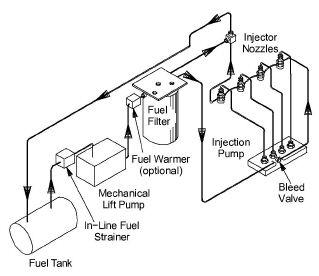
2.3.4Lube Oil Filter Arrangement
The engine lubricating oil filter is mounted in a horizontal arrangement and shown in Figure 2.5.
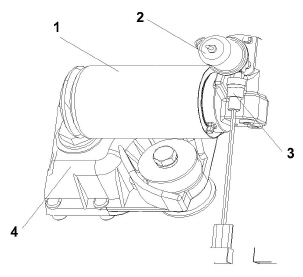
1.Oil Filter (Primary)
2.Oil Pressure Sender
3.Oil Pressure Switch
4.Oil Pan
All threads used on the engine are metric except for the oil drain plug, which is American Standard Pipe Thread (NPT).
2.5ALTERNATING CURRENT GENERATOR
The Marathon Alternator Company (Lima) brushless alternating current generator (see Figure 2.2) is a self-regulated, rotating field synchronous unit. The generator stator and exciter stator are combined in a common housing. The generator field, exciter rotor, and rotating rectifier assembly are mounted on a common shaft. The output of the exciter rotor is applied to the generator field winding through a rotating, full-wave bridge, silicon rectifier unit.
All connections between the exciter stator windings and the generator stator windings are internal within the stator housing. Only the output power leads are connected at the terminal box, located on top of the generator.
Figure 2.6 A-C Generator Circuit Diagram
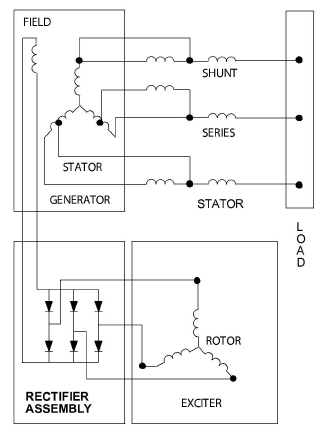
2.5.2Alternating Current Generator Diagram
Figure 2.6 shows the internal schematic diagram of the generator, exciter, and rectifier unit. The generator is a three-phase unit, and the exciter stator and exciter rotor also have three-phase windings. A portion of the exciter stator windings is connected across a tap on the generator stator winding. This exciter shunt winding provides the generator field excitation power required for the generator no-load voltage. Another portion of exciter stator windings is connected in series with the output of the generator and provides a compounding excitation characteristic.
The rotor is, in effect, the secondary of a rotating current transformer induction frequency converter. The exciter rotor output voltage is applied to the generator field windings by a three-phase, full wave rotating silicon rectifier unit. The response time of the excitation system is very fast as the exciter stator carries an alternating current corresponding to the load current that appears immediately on the exciter primary. An increase in load current will cause an immediate increase in the exciter secondary output voltage, which is rectified and applied to the generator field windings. The inherent compounding characteristics of the excitation system provide excellent voltage regulation even under heavy overload conditions.
The solid state battery charger (see Figure 2.2) is located on top of the generator. The charger is powered by the generator, and this input is protected by a circuit breaker located on the control panel. The battery charger produces a tapered charge (25 amps maximum) and is designed not to overcharge the battery.
Observe proper polarity when installing the battery or connecting a battery charger. The negative battery terminal must be grounded. Reverse polarity may damage the charging system. When charging the battery in unit, isolate the battery by disconnecting the negative battery terminal first, then the positive. Once the battery has been charged, connect the positive battery terminal first, then the negative.
2.7OPERATING CONTROLS & INSTRUMENTS
Components required for monitoring and controlling the unit are located in the control box, on the control panel (see Figure 2.1) and on the receptacle box (see Figure 2.1).
2.7.2Control Panel and Related Components
a. Gauges and Senders
1.Oil Pressure Gauge (see Figure 2.7 or Figure 2.8)
The purpose of this gauge is to observe normal operating engine oil pressure. Normal oil pressure is 35 to 60 psig (3.3 to 5.2 kg/cm2).
2.Oil Pressure Sender (see Figure 2.5)
This device senses engine lube oil pressure and transmits a signal to the oil pressure gauge. The oil pressure sender is located on the oil filter housing.
3.Water Temperature Gauge (see Figure 2.7 or Figure 2.8)
The function of this gauge is to observe water operating temperature. The gauge is connected to the water temperature sender.
4.Water Temperature Sender
This device (see Figure 2.2) senses engine water temperature and transmits a signal to the water temperature gauge. The water temperature sender is located on the top, left-hand side of the engine below the high water temperature switch.
5.Auto Restart Module (If So Equipped) (see Figure 2.8)
Auto start/restart is provided to simplify the start-up process and provide an automatic restart feature that will automatically attempt to restart the unit in the event of shutdown. Four LEDs are used to indicate shutdown from overcrank, overspeed, low oil pressure, and high water temperature. A fifth LED is used to indicate the unit is running. Refer to Table 2–2 for system preset values.
The auto restart function will perform a series of six attempts to restart the unit and make three attempts within each series. Once the function has completed all 18 attempts, the unit will automatically lock out future crank attempts. Refer to Table 2–3 for detailed information on auto restart sequencing.
b. Meters
1.Ammeter (A) (see Figure 2.7 or Figure 2.8)
The ammeter is an indicator of the charging system and unit electrical draw. It indicates the rate of discharge or charge of the battery. During start up, the intake heater draws approximately 42 amps.
2.Total Time Meter (TT) (see Figure 2.7 or Figure 2.8)
This meter designates the total hours and provides an accurate readout of accumulated engine running time. This data can be used to establish the proper periodic maintenance schedule. (Refer to Table 5–1.)
c. Manual Switches
1.Intake Heater Switch (HS)
The intake heater switch is of the momentary type. When held in the PREHEAT position, the switch allows approximately 42 amps of battery current to flow into the intake heater, which preheats the air within the intake manifold and allows the engine to start. After starting the engine, the intake heater switch should continue to be held in the ON position for approximately 5 seconds until the engine has developed enough oil pressure to close the oil pressure safety switch.
2.Ignition Switch (IGN) (see Figure 2.7)
The ignition switch is of the momentary type to be used in the OFF/ON/START positions. When held in the START (ignition) position, it energizes the starter motor solenoid, which in turn allows the starter motor to crank the engine. The switch is released to the RUN position once the engine has started.
3.Ignition Switch (IGN) (Auto Restart) (see Figure 2.8)
The ignition switch is of the maintained contact type to be used in the RUN/OFF positions. When switched to the RUN position, it energizes the control module, which in turn controls all functions of the genset.
4.Operating Mode Switch (If So Equipped) (see Figure 2.7 and Figure 2.8)
The Operating Mode (Dual Speed) switch is of the maintained contact type to be used in the ECONOMY/POWER positions. When switched to the ECONOMY position, it energizes the dual speed timer control module, which signals the programmed electronic governor module (EG) to reduce engine speed from 1800 RPM to 1500 RPM after a period of two (2) hours.
d. Timers
1.Intake Heater Timer (IHT) (If So Equipped)
The Intake Heater Timer continues to supply power to the intake heater for 3 minutes after initial start-up.
2.Dual Speed Timer (DT) (If So Equipped)
The Dual Speed Timer provides power to the electronic governor module for a 2 hour period to maintain initial high speed operation.
Figure 2.7 Standard Control Panel Box and Panel With Dual Speed Option
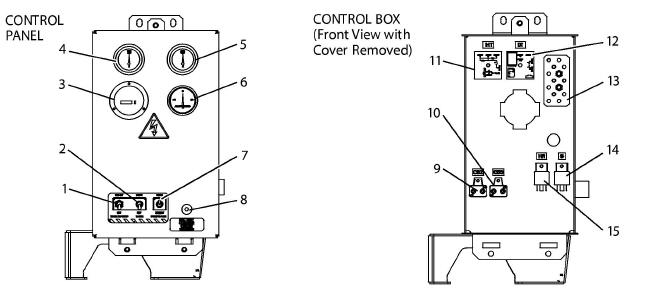
1.Intake Heater Switch
2.Ignition Switch
3.Total Time Meter
4.Water Temperature Gauge
5.Oil Pressure Gauge
6.Ammeter
7.Operating Mode Switch (If Equipped)
8.Battery Charger Fuse or Circuit Breaker (CB5)
9.Circuit Breaker (CB2)
10.Circuit Breaker (CB3)
11.Intake Heater Timer
12.Dual Speed Timer (If Equipped)
13.Ground Strap Assembly
14.Safety Relay
15.Intake Heater Relay
- - - - -
Figure 2.8 Auto Restart Control Box and Panel With Dual Speed Option
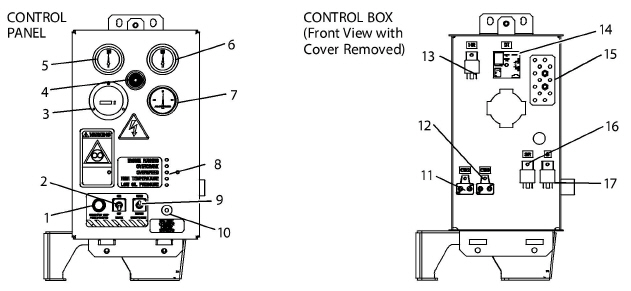
1.Engine Start/Intake Heater Energized Light
2.Ignition Switch
3.Total Time Meter
4.Engine Start Alarm (Buzzer)
5.Water Temperature Gauge
6.Oil Pressure Gauge
7.Ammeter
8.Auto Restart Module
9.Operating Mode Switch (If Equipped)
10.Battery Charger Fuse or Circuit Breaker (CB5)
11.Circuit Breaker (CB2)
12.Circuit Breaker (CB3)
13.Intake Heater Relay
14.Dual Speed Timer (If Equipped)
15.Ground Strap Assembly
16.Starter Relay
17.Safety Relay
- - - - -
Indicator |
Preset Value |
Description |
|---|---|---|
Overspeed |
2100 RPM |
Overspeed is the point at which the unit will signal for shutdown. |
Crank Disconnect |
700 RPM |
Crank Disconnect is the point at which the Auto Restart module senses the engine has started and will disengage the starter. |
Shutdown Lockout Delay |
15 seconds |
The oil pressure and water temperature inputs are ignored during this 15 second delay (during startup). |
Intake Heater Delay |
30 seconds preheat 3 minutes post heat |
The delay is used during start up. The intake heater delay begins timing after the Auto Restart module signal is received. During the entire delay, the intake heater circuit will be energized, an indicator light will be illuminated, and an alarm will sound. When the delay expires, the unit will crank. |
Crank Attempts |
18 attempts |
A series of six attempts with three attempts in each series (total of 18 attempts), refer to Table 2–3, Auto Restart Sequencing. |
Table
2–3 Auto
Restart Sequencing
*Engine crank and rest is repeated three times each series unless the engine
starts.
Series Attempt Number
|
Intake Heater Energized in Seconds |
Fuel Solenoid Engaged |
Engine Crank Duration (Seconds) |
Engine Rest Duration (Seconds) |
|---|---|---|---|---|
1 |
30 |
X |
Up To 15 |
25 |
If the engine starts: a. Run sequence begins b. Intake heater remains energized for 3 minutes If the engine fails to start: a. Intake heater will de-energize. b. Fuel solenoid will de-energize. c. Crank output will de-energize. d. Overcrank LED will flash once. Wait two seconds and repeat. e. Unit will rest 30 minutes and proceed to the next series. |
||||
2 |
30 |
X |
Up To 15 |
25 |
If the engine starts: a. Run sequence begins. b. Intake heater remains energized for 3 minutes. If the engine fails to start: a. Intake heater will de-energize. b. Fuel solenoid will de-energize. c. Crank output will de-energize. d. Overcrank LED will flash twice. Wait two seconds and repeat. e. Unit will rest 30 minutes and proceed to the next series. |
||||
3 |
30 |
X |
Up To 15 |
25 |
If the engine starts: a. Run sequence begins. If the engine fails to start: a. Intake heater will de-energize. b. Fuel solenoid will de-energize. c. Crank output will de-energize. d. Overcrank LED will flash three times. Wait two seconds and repeat. e. Unit will rest five hours and proceed to the next series. |
||||
4 |
30 |
X |
Up To 15 |
25 |
If the engine starts: a. Run sequence begins. If the engine fails to start: a. Intake heater will de-energize. b. Fuel solenoid will de-energize. c. Crank output will de-energize. d. Overcrank LED will flash four times. Wait two seconds and repeat. e. Unit will rest five hours and proceed to the next series. |
||||
5 |
30 |
X |
Up To 15 |
25 |
If the engine starts: a. Run sequence begins. If the engine fails to start: a. Intake heater will de-energize. b. Fuel solenoid will de-energize. c. Crank output will de-energize. d. Overcrank LED will flash five times. Wait two seconds and repeat. e. Unit will rest five hours and proceed to the next series. |
||||
6 |
30 |
X |
Up To 15 |
25 |
If the engine starts: a. Run sequence begins. If the engine fails to start: a. Intake heater will de-energize. b. Fuel solenoid will de-energize. c. Crank output will de-energize. d. Overcrank LED will illuminate solid and lock out future crank attempts. e. To reset, turn unit power switch OFF and back ON. |
||||
Safety devices, such as circuit breakers, fuses, and safety switches, protect system components from damage.
The AC generator, solid state battery charger, fuel heater, high water temperature, safety relay, total time meter and intake heater are protected by circuit breakers. If a safety device opens and there is an interruption of electrical current, the electronic governor module will be de-energized, which will also de-energize the fuel solenoid, interrupt the fuel flow to the engine and stop the engine.
In units with auto restart, the engine, engine control devices, and engine monitoring devices are protected by the auto restart module, circuit breaker, low oil pressure switch, and high water temperature switch. These safety devices monitor system operating conditions and open a set of electrical contacts when an unsafe condition occurs. If a safety device opens and there is an interruption of electrical current, the electronic governor module will be de-energized, which will also de-energize the fuel solenoid, interrupt the fuel flow to the engine and stop the engine.
De-energizing the fuel solenoid shuts off the fuel supply to the engine; thus stopping the engine. Safety device specifications are provided in Table 2–4.
a. Fuel Tanks |
Nominal Tank Sizes |
Fill Capacity |
Draw Capacity |
130 Gallon |
130 Gallon |
124 Gallon* |
*Allows for DOT required 5% vapor space
b. Weights |
Battery |
63 lb (28.6 kg) |
Generator (A-C) |
280 lb (127 kg) |
|
Engine (Dry) - without Accessories |
439 lb (199 kg) Approximate |
|
Unit (dry, with 130 gallon tank) |
1830 lb (830.1 kg) |
a. Bore/Stroke |
3.26 in. (83 mm) / 4.03 in. (102.4 mm) |
|
b. Compression Ratio |
21.5 : 1 |
|
c. Cylinders (Number) |
Four |
|
d. Displacement |
135.2 cubic inches (2.22 liters) |
|
e. Firing Order |
1−3−4−2 |
|
f. Lubrication System |
Oil Pressure Safety Switch Setting Opens |
18 psig (1.27 kg/cm2) |
Capacity |
Engine - 16.0 US quarts (15.1 liters), includes standard filter. |
|
Oil Level Indicator |
Dipstick in oil pan or fill cap NOTE: |
|
Lube Oil Specification |
Use a heavy duty lubricating oil conforming to American Petroleum Institute (API) Service Classification CG, CH or CI, Base Number 10 or above. |
|
Lube Oil Viscosity (Outdoor Temperature) |
Fahrenheit: 0°F to 45°F Centigrade: -18°C to 7°C SAE: 10W30 |
|
Fahrenheit: 45°F and above Centigrade: 7°C and above SAE: 10W30 or 15W40 |
||
g. Fuel and Fuel Heater Thermostat (FHT) |
Winter |
Summer |
Diesel No. 1 |
Diesel No. 2 |
|
FHT |
||
Close on temperature fall @ 45+/− 6.5°F |
Open on temperature rise @ 75+/− 6.5°F |
|
Power Consumption: 150 Watts @ +/− 10% at 14 VDC |
||
h. Fuel Warmer |
Coolant Temperature |
|
i. Intake Heater |
Amperage - 42 amps at 12 VDC |
|
Resistance (cold) - Approx. 0.3 ohms |
||
j. Horsepower |
27 HP @ 1800 RPM at 3000 feet above sea level |
|
32 HP @ 1800 RPM at sea level |
||
k. Cooling System |
Capacity |
6 U.S. quarts (5.68 liters) - includes 1 quart (0.95 liter) in coolant recovery bottle. (Refer to Section 5.4.5) |
Anti-Freeze: Conventional |
The cooling system may be factory charged with a 50/50 mix of ethylene glycol and water. This mixture provides protection to -34F (-37C). For replacement, use a low silicate anti-freeze meeting GM specifications GM 6038M or equal. Again, a 50/50 mix is recommended. |
|
Anti-Freeze: Extended Life |
The cooling system may be factory charged with a 50/50 mix of extended life coolant (ELC) and deionized water. This mixture provides protection to -34F (-37C). For replacement, with extended life coolant (ELC) meeting GM specification GM6277M and deionized water. Again, a 50/50 mix is recommended. Extended life coolant is red or orange in color. DO NOT mix with conventional coolant. |
|
Water Temperature Safety Switch Setting |
||
Opens |
230 +/− 5°F (110 +/− 3°C) |
|
Resets |
200°F (93°C) - minimum |
|
Thermostat: |
||
Starts to open |
177 to 182°F (80 to 84°C) |
|
Fully open |
203°F (95°C) |
|
l. Lubrication System |
Oil Pressure |
35 to 60 psig (3.3 to 5.2 kg/cm2) |
m. Electrical |
Generator |
460 VAC (+/− 10%) @ 60 hz |